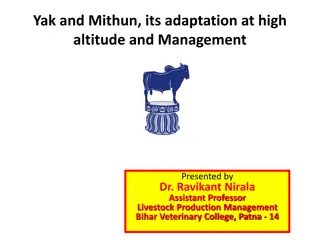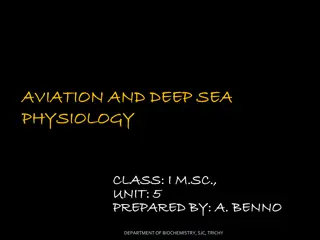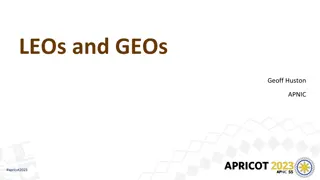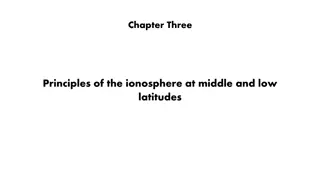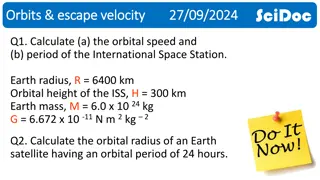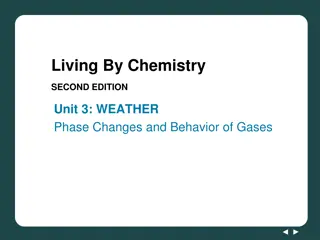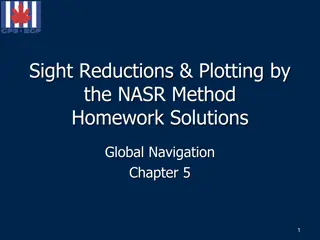Effective Techniques for Overwater Search and Rescue Operations
Discover essential strategies for conducting successful overwater search and rescue missions, including guidelines on parachute opening altitudes, sweep width calculations, and active vs. passive search approaches. Learn how to utilize correction factors for weather, fatigue, and airspeed to enhance
0 views • 37 slides
Adaptation of Yak and Mithun at High Altitude
Yak and Mithun are domesticated bovids known for their adaptation to high altitudes in the Himalayan region. Yaks, descended from wild yaks, are used for various purposes like transportation, climbing, and trekking. They have specific mating behaviors and unique anatomical modifications for high alt
0 views • 18 slides
Introduction to Levelling in Civil Engineering
Levelling in civil engineering involves determining relative heights of points on or below the earth's surface. This process helps in preparing contour maps, determining altitudes, preparing engineering project sections, and layout maps for various schemes. Terms used in levelling, instruments like
0 views • 29 slides
High-Altitude Physiology and Its Effects on the Human Body
Understanding the impact of high altitudes on human physiology is crucial for aviation and deep-sea activities. Barometric pressures and alveolar oxygen levels change significantly with altitude, leading to hypoxia-related issues. Factors like carbon dioxide and water vapor further affect alveolar o
1 views • 29 slides
Understanding Atmospheric Pressure Variations at Different Altitudes
Atmospheric pressure varies with altitude due to the weight of the air column above. This activity explores how Otto von Guericke's experiments with vacuum systems demonstrate the power of air pressure. Theoretical concepts of atmospheric pressure are discussed, highlighting its relation to gravity
0 views • 28 slides
Exploring Satellite Orbits and Space Missions
This content covers a variety of topics related to satellites, including geosynchronous orbit, satellite history, organisms sent to orbit, types of orbits, orbital altitudes, and current satellite usage. It delves into the history of satellite launches, types of orbits, and the functions of satellit
0 views • 20 slides
Understanding Orbital Altitudes and Satellite Services
Explore the fascinating realm of orbital altitudes and satellite services, including the differences between Low Earth Orbit (LEO) and Geostationary Earth Orbit (GEO). Learn about the physics behind satellite trajectories and how services like Starlink and Skymuster provide unique communication solu
0 views • 35 slides
Understanding Barometric Pressure and Its Impact on Altitude
Barometric pressure, also known as atmospheric pressure, is the force exerted by the weight of air on a specific area and varies with altitude. This pressure is crucial in various industries, such as cement production at high altitudes. Learn about how to calculate barometric pressure, its relation
0 views • 37 slides
Exploring Heights and Rivers in Nebraska
Discover the diverse elevations across Nebraska, from the soaring peaks of Scottsbluff and Harrison to the river landscapes of Missouri, Republican, and Platte. Explore the varying altitudes of cities like Omaha, Lincoln, and Grand Island, offering unique perspectives from 1,175 to 4,865 feet above
0 views • 34 slides
Analyzing Tallest Mountains in the Solar System
This document explores the tallest mountains in the Solar System and proposes theoretical models for predicting their maximum altitudes on various celestial bodies. It discusses the heights of mountains on Mercury, Earth, Moon, Mars, Vesta, Ceres, Io, and other celestial bodies, along with different
0 views • 29 slides
Understanding Ionospheric Absorption Laws and Regions
The principles of the ionosphere at middle and low latitudes, Lambert-Beer exponential absorption law, and characteristics of E and F regions are discussed. The absorption of solar radiation, recombination reactions in different regions, and ionization processes are highlighted, providing insights i
0 views • 15 slides
Orbital Mechanics and Satellites Overview
This content provides calculations for the orbital speed and period of the International Space Station, as well as the orbital radius of an Earth satellite with a 24-hour period. It explains the concept of artificial satellites, different types of orbits such as Low Earth Orbit (LEO), Medium Earth O
0 views • 17 slides
Ascites in Broiler Chickens: Causes, Symptoms, and Management
Ascites is a common disease in broiler chickens, especially at high altitudes. It is characterized by fluid accumulation in the peritoneal cavity or pericardial sac, often containing yellow protein clots. Predisposing factors include reduced ventilation, high altitude, and respiratory disease. Sympt
0 views • 13 slides
Understanding Tephigrams for Soaring Weather Forecasting
Tephigrams are essential tools for glider pilots to analyze atmospheric conditions for soaring flights. They display data on air temperature, dew point, and wind velocity, helping in assessing thermal activity and potential wave days. By examining tephigrams, pilots can determine the presence of clo
0 views • 26 slides
Understanding Gas Laws in Weather Phenomena
Exploring the behavior of gases in weather-related scenarios, such as the ascent of helium-filled weather balloons, by applying the combined gas law to analyze the relationships among pressure, volume, and temperature. The discussion delves into the impact of changing variables on gas properties, em
0 views • 11 slides
Celestial Navigation: NASR Method Homework Solutions
Calculate altitudes, intercepts, and azimuths of celestial bodies using the NASR method. Plot celestial lines of position (LOPs) and fixes based on sights taken on the sun, moon, planets, or stars. Explore comparisons between the Law of Cosines and NASR methods for sight reduction. Practice plotting
0 views • 5 slides

